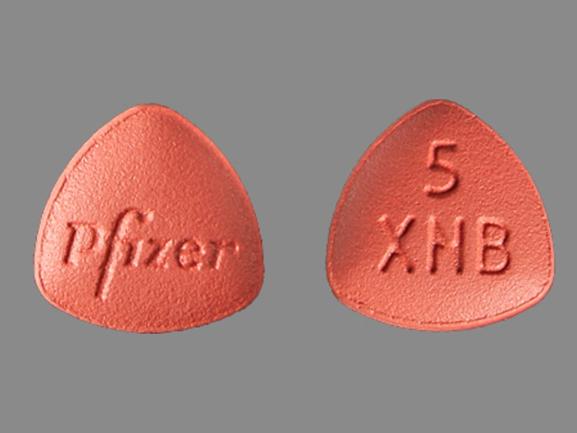Axitinib Dosage
Medically reviewed by Drugs.com. Last updated on Sep 27, 2024.
Applies to the following strengths: 1 mg; 5 mg
Usual Adult Dose for:
Additional dosage information:
Usual Adult Dose for Renal Cell Carcinoma
Initial dose: 5 mg orally twice a day
Maintenance dose: Increase or decrease dose based on individual safety and tolerability
Dose range: 2 to 10 mg twice a day
Comments: Doses should be taken approximately 12 hours apart.
Use: For the treatment of advanced renal cell carcinoma after the failure of 1 prior systemic therapy.
Renal Dose Adjustments
Mild to severe renal impairment (CrCl 15 mL/min to less than 89 mL/min): No adjustment to starting dose recommended
Severe renal impairment (CrCl less than 15 mL/min): Use with caution
Liver Dose Adjustments
Mild hepatic impairment (Child-Pugh class A): No adjustment to starting dose recommended
Moderate hepatic impairment (Child-Pugh class B): Decrease the starting dose by one-half
Severe hepatic impairment (Child-Pugh class C): Not recommended as not studied in these patients
Dose Adjustments
Dose increases or dose reductions should be made based on individual patient safety and tolerability.
Dose Increases:
- For patients who tolerate this drug for at least 2 consecutive weeks with no adverse reactions greater than grade 2, are normotensive, and are not receiving antihypertensive medication may increase dose.
- Dose increases should step from 5 mg twice a day to 7 mg twice a day to 10 mg twice a day based on same criteria.
Dose Reductions:
- Some adverse reactions including hypertension, proteinuria, and hepatic impairment should be managed by dose reduction; if dose reduction is necessary decrease to 3 mg twice a day, then 2 mg twice a day if further reduction is necessary.
Discontinuation or Temporary Interruption:
- Some adverse reactions should be managed by temporary interruption or permanent discontinuation of therapy; these include persistent hypertension despite treatment, hypertensive crisis, cardiac failure, and reversible posterior leukoencephalopathy syndrome.
Strong CYP450 3A4/5 Inhibitors and Inducers:
- Strong CYP450 3A4/5 inhibitors may increase axitinib exposure
- Strong CYP450 3A4/5 inducers may decrease axitinib exposure
- Select an alternative concomitant medication with no or minimal CYP450 3A4/5 inhibition or induction.
- If coadministration with strong CYP450 3A4/5 inhibitors is necessary, consider reducing axitinib starting dose by one-half; subsequent doses can be increased or decreased based safety and tolerability.
- If coadministration of the strong inhibitor is discontinued, the axitinib dose should be returned (after 3 to 5 half-lives of the inhibitor) to the recommended dose.
- Coadministration with strong and moderate CYP450 3A4/5 inducers should be avoided; maximal induction has been reported to occur within 1 week.
Precautions
CONTRAINDICATIONS:
- None
Safety and efficacy have not been established in patients younger than 18 years.
Consult WARNINGS section for additional precautions.
Dialysis
Data not available.
Other Comments
Administration advice:
- May be taken with or without food; take approximately 12 hours apart
- Swallow whole with a glass of water
- If patient vomits or a dose is missed, an additional dose should not be taken; next dose should be taken at the usual time
General:
Therapy should be initiated by a physician experienced in the administration of anti-cancer agents.
Monitoring:
- LFTs, thyroid function tests, blood pressure, and urinalyses for proteinuria, baseline, and periodically during therapy.
- Monitor for signs or symptoms of cardiac failure.
Patient Advice:
- Advise patient to contact healthcare provider if they experience cardiac symptoms, vision changes, hypertension, bleeding, persistent or severe abdominal pain, symptoms of abnormal thyroid function, or worsening of neurologic function consistent with reversible posterior leukoencephalopathy syndrome.
- Advise patients that this drug may cause blood clots; if they have symptoms suggestive of a blood clot they should seek immediate medical help.
- Advise both male and female patients to use effective contraception during therapy; if pregnancy is suspected, patients should seek medical advice and counseling.
- Advise patients to avoid grapefruit (juice and fruit).
Frequently asked questions
More about axitinib
- Check interactions
- Compare alternatives
- Reviews (3)
- Side effects
- During pregnancy
- Drug class: multikinase inhibitors
- Breastfeeding
- En español
Patient resources
Other brands
Professional resources
Other brands
Related treatment guides
See also:
Further information
Always consult your healthcare provider to ensure the information displayed on this page applies to your personal circumstances.


